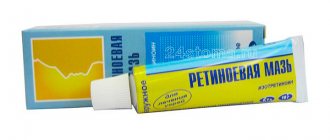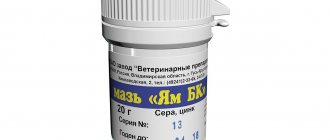Nosological classification (ICD-10)
- A49.3 Mycoplasma infection, unspecified
- A53.9 Syphilis, unspecified
- A54 Gonococcal infection
- A55 Chlamydial lymphogranuloma (venereal)
- A69.2 Lyme disease
- A70 Chlamydia psittaci infection
- A75 Typhus
- H60 Otitis externa
- H66 Suppurative and unspecified otitis media
- H70 Mastoiditis and related conditions
- J01 Acute sinusitis
- J02.9 Acute pharyngitis, unspecified
- J03.9 Acute tonsillitis, unspecified (angina agranulocytic)
- J04 Acute laryngitis and tracheitis
- J06 Acute upper respiratory tract infections of multiple and unspecified localization
- J22 Acute respiratory infection of the lower respiratory tract, unspecified
- J31 Chronic rhinitis, nasopharyngitis and pharyngitis
- J32 Chronic sinusitis
- J35.0 Chronic tonsillitis
- J37 Chronic laryngitis and laryngotracheitis
- K62.8.1* Proctitis
- L08.9 Local infection of skin and subcutaneous tissue, unspecified
- L70 Acne
- M60.0 Infectious myositis
- M65 Synovitis and tenosynovitis
- M65.0 Tendon sheath abscess
- M71.0 Abscess of bursa
- M71.1 Other infectious bursitis
- M86 Osteomyelitis
- N30 Cystitis
- N34 Urethritis and urethral syndrome
- N39.0 Urinary tract infection without established location
- N41 Inflammatory diseases of the prostate gland
- N49 Inflammatory diseases of the male genital organs, not elsewhere classified
- N71 Inflammatory diseases of the uterus, except the cervix
- N73.9 Inflammatory diseases of the female pelvic organs, unspecified
- N74.2 Inflammatory diseases of the female pelvic organs caused by syphilis (A51.4+, A52.7+)
- N74.3 Gonococcal inflammatory diseases of the female pelvic organs (A54.2+)
Pharmacodynamics
Broad-spectrum antibiotic from the tetracycline group. It acts bacteriostatically, suppresses protein synthesis in the microbial cell by interacting with the 30S ribosomal subunit. Active against many gram-positive and gram-negative microorganisms: Streptococcus spp., Treponema spp., Staphylococcus spp., Klebsiella spp., Enterobacter spp. (including E. aerugenes), Neisseria gonorrhoeae, Neisseria meningitidis, Haemophilus influenzae, Chlamydia spp., Mycoplasma spp., Ureaplasma urealyticum, Listeria monocytogenes, Rickettsia spp., Typhus exanthematicus, Escherichia coli, Shigella spp., Campylobacter fetus, Vibrio cholerae, Yersinia spp. (including Yersinia pestis), Brucella spp., Francisella tularensis, Bacillus anthracis, Bartonella bacilliformis, Pasteurella multocida, Borrelia recurrentis, Clostridium spp. (except Clostridium difficile), Actinomyces spp., Fusobacterium fusiforme, Calymmatobacterium granulomatis, Propionibacterium acnes, some protozoa (Entamoeba spp., Plasmodium falciparum).
As a rule, it has no effect on Acinetobacter spp., Proteus spp., Pseudomonas spp., Serratia spp., Providencia spp., Enterococcus spp.
The possibility of acquired resistance to doxycycline in a number of pathogens, which is often cross-linked within a group, should be taken into account (i.e., strains resistant to doxycycline will simultaneously be resistant to the entire group of tetracyclines).
Pharmacokinetics
Suction
Absorption is fast and high (about 100%). Food intake has little effect on the absorption of the drug.
Cmax of doxycycline in blood plasma (2.6–3 μg/ml) is achieved 2 hours after taking 200 mg; after 24 hours, the concentration of the active substance in blood plasma decreases to 1.5 μg/ml.
After taking 200 mg on the first day of treatment and 100 mg/day on subsequent days, the plasma concentration of doxycycline is 1.5–3 mcg/ml.
Distribution
Doxycycline binds reversibly to plasma proteins (80–90%), penetrates well into organs and tissues, poorly into the cerebrospinal fluid (10–20% of plasma levels), however, the concentration of doxycycline in the cerebrospinal fluid increases with inflammation spinal membrane.
Volume of distribution - 1.58 l/kg. 30–45 minutes after oral administration, doxycycline is found in therapeutic concentrations in the liver, kidneys, lungs, spleen, bones, teeth, prostate gland, eye tissue, pleural and ascitic fluids, bile, synovial exudate, exudate of the maxillary and frontal sinuses, in gingival sulcus fluids.
With normal liver function, the level of the drug in bile is 5–10 times higher than in plasma.
In saliva, 5–27% of the concentration of doxycycline in blood plasma is determined.
Doxycycline crosses the placental barrier and is secreted into breast milk in small quantities.
Accumulates in dentin and bone tissue.
Metabolism
A small portion of doxycycline is metabolized.
Removal
T1/2 after a single oral dose is 16-18 hours, after repeated doses - 22-23 hours.
Approximately 40% of the drug taken is excreted by the kidneys and 20–40% is excreted through the intestines in the form of inactive forms (chelates).
Pharmacokinetics in special clinical situations
The half-life of the drug in patients with impaired renal function does not change, because its excretion through the intestines increases.
Hemodialysis and peritoneal dialysis do not affect the concentration of doxycycline in blood plasma.
Unidox Solutab 100 mg 10 pcs. dispersible tablets
pharmachologic effect
Antibiotic, tetracycline.
Composition and release form Unidox Solutab 100 mg 10 pcs. dispersible tablets
Tablets - 1 tablet:
- Active substance: doxycycline monohydrate 100.0 mg in terms of doxycycline;
- Excipients: microcrystalline cellulose - 45.0 mg, saccharin - 10.0 mg, hyprolose (low-substituted) - 18.75 mg, hypromellose - 3.75 mg, colloidal silicon dioxide (anhydrous) -0.625 mg, magnesium stearate - 2, 0 mg, lactose monohydrate - up to 250.0 mg.
Dispersible tablets 100 mg.
10 tablets in a PVC/aluminum foil blister. 1 blister along with instructions for use in a cardboard box.
Description of the dosage form
Round, biconvex tablets, light yellow or grey-yellow to speckled brown, engraved “173” (tablet code) on one side and scored on the other.
Characteristic
Broad-spectrum antibiotic from the tetracycline group.
Directions for use and doses
Usually the duration of treatment is 5-10 days. The tablets are dissolved in a small amount of water (about 20 ml) to obtain a suspension; they can also be swallowed whole, divided into pieces or chewed with water. Preferably taken with food.
Take the tablets while sitting or standing, which reduces the likelihood of developing esophagitis and esophageal ulcers. The drug should not be taken immediately before bedtime.
Adults and children over 8 years of age weighing more than 50 kg are prescribed 200 mg in 1-2 doses on the first day of treatment, then 100 mg daily. In cases of severe infections, Unidox is prescribed at a dose of 200 mg daily throughout treatment.
For children 8-12 years old weighing less than 50 kg, the average daily dose is 4 mg/kg on the first day, then 2 mg/kg per day (in 1-2 doses). In cases of severe infection, Unidox is prescribed at a dose of 4 mg/kg daily throughout treatment.
Features of dosing for certain diseases
For infection caused by S.pyogenes, Unidox is taken for at least 10 days. For uncomplicated gonorrhea (excluding anorectal infections in men):
Adults are prescribed 100 mg twice a day until complete cure (on average within 7 days), or for one day they are prescribed 600 mg - 300 mg in 2 doses (the second dose 1 hour after the first).
For primary syphilis, 100 mg is prescribed twice a day for 14 days, for secondary syphilis - 100 mg twice a day for 28 days. For uncomplicated urogenital infections caused by Chlamydia trachomatis, cervicitis, non-gonococcal urethritis caused by Ureaplasma urealiticum, 100 mg is prescribed 2 times a day for 7 days.
For acne, 100 mg/day is prescribed, the course of treatment is 6-12 weeks.
Malaria (prevention): 100 mg 1 time per day 1-2 days before the trip, then daily during the trip and for 4 weeks after return; for children over 8 years old, 2 mg/kg 1 time per day.
The duration of prophylaxis should not exceed 4 months. Traveler's diarrhea (prevention) - 200 mg on the first day of the trip (in 1 dose or 100 mg 2 times a day), then 100 mg 1 time per day throughout your stay in the region (no more than 3 weeks).
Treatment of leptospirosis - 100 mg orally 2 times a day for 7 days; prevention of leptospirosis - 200 mg once a week during your stay in a disadvantaged area and 200 mg at the end of the trip.
To prevent infections during medical abortion, 100 mg is prescribed 1 hour before and 200 mg after the intervention.
Maximum daily doses for adults are up to 300 mg/day or 600 mg/day for 5 days for severe gonococcal infection. For children over 8 years old with a body weight of more than 50 kg - up to 200 mg, for children 8 - 12 years old with a body weight less than 50 kg - 4 mg/kg daily during the entire treatment period.
In the presence of renal (creatinine clearance less than 60 ml/min) and/or liver failure, a reduction in the daily dose of doxycycline is required, since this leads to a gradual accumulation of it in the body (risk of hepatotoxicity).
Pharmacodynamics
Broad-spectrum antibiotic from the tetracycline group. It acts bacteriostatically, suppresses protein synthesis in the microbial cell by interacting with the 30S ribosomal subunit. Active against many gram-positive and gram-negative microorganisms: Streptococcus spp., Treponema spp., Staphylococcus spp., Klebsiella spp., Enterobacter spp. (including E. aerugenes), Neisseria gonorrhoeae, Neis seria meningitidis, Haemophilus influenzae, Chlamydia spp., Mycoplasma spp., Ureaplasma urealyticum, Listeria monocytogenes, Rickettsia spp., Typhus exanthematicus, Escherichia coli, Shigella spp., Campylobacter fetus , Vibrio cholerae, Yersinia spp. (including Yersinia pestis), Brucella spp., Francisella tularensis, Bacillus anthracis, Bartonella bacilliformis, Pasteurella multocida, Borrelia recurrentis, Clostridium spp. (except Clostridium difficilé), Actinomyces spp., Fusobacterium fusiforme, Calymmatobacterium granulomatosis, Propionibacterium acnes, some protozoa (Entamoeba spp., Plasmodium falciparum).
As a rule, it has no effect on Acinetobacter spp., Proteus spp., Pseudomonas spp., Serratia spp., Providencia spp., Enterococcus spp.
The possibility of acquired resistance to doxycycline in a number of pathogens, which is often cross-linked within a group, should be taken into account (i.e., strains resistant to doxycycline will simultaneously be resistant to the entire group of tetracyclines).
Pharmacokinetics
Suction
Absorption is fast and high (about 100%). Food intake has little effect on the absorption of the drug.
The maximum level of doxycycline in the blood plasma (2.6-3 mcg/ml) is achieved 2 hours after taking 200 mg; after 24 hours, the concentration of the active substance in the blood plasma decreases to 1.5 mcg/ml.
After taking 200 mg on the first day of treatment and 100 mg per day on subsequent days, the plasma concentration of doxycycline is 1.5-3 mcg/ml.
Distribution
Doxycycline binds reversibly to plasma proteins (80-90%), penetrates well into organs and tissues, poorly into the cerebrospinal fluid (10-20% of the level in the blood plasma), however, the concentration of doxycycline in the cerebrospinal fluid increases with inflammation of the spinal membrane.
Volume of distribution - 1.58 l/kg. 30-45 minutes after oral administration, doxycycline is found in therapeutic concentrations in the liver, kidneys, lungs, spleen, bones, teeth, prostate gland, eye tissue, pleural and ascitic fluids, bile, synovial exudate, exudate of the maxillary and frontal sinuses, in gingival sulcus fluids.
With normal liver function, the level of the drug in bile is 5-10 times higher than in plasma.
In saliva, 5-27% of the concentration of doxycycline in blood plasma is determined.
Doxycycline crosses the placental barrier and is secreted into breast milk in small quantities.
Accumulates in dentin and bone tissue.
Metabolism
A small portion of doxycycline is metabolized.
Removal
The half-life after a single oral dose is 16-18 hours, after repeated doses it is 22-23 hours.
Approximately 40% of the drug taken is excreted by the kidneys and 20 - 40% is excreted through the intestines in the form of inactive forms (chelates).
Pharmacokinetics in special clinical situations
The half-life of the drug in patients with impaired renal function does not change, because its excretion through the intestines increases.
Hemodialysis and peritoneal dialysis do not affect the concentration of doxycycline in blood plasma.
Indications for use Unidox Solutab 100 mg 10 pcs. dispersible tablets
Infectious and inflammatory diseases caused by microorganisms sensitive to the drug:
- respiratory tract infections, including pharyngitis, acute bronchitis, exacerbation of chronic obstructive pulmonary disease, tracheitis, bronchopneumonia, lobar pneumonia, community-acquired pneumonia, lung abscess, pleural empyema;
- infections of the ENT organs, including otitis media, sinusitis, tonsillitis;
- infections of the genitourinary system: cystitis, pyelonephritis, bacterial prostatitis, urethritis, urethrocystitis, urogenital mycoplasmosis, acute orchiepididymitis; endometritis, endocervicitis and salpingoophioritis as part of combination therapy; including sexually transmitted infections: urogenital chlamydia, syphilis in patients with penicillin intolerance, uncomplicated gonorrhea (as an alternative therapy), granuloma inguinale, lymphogranuloma venereum;
- infections of the gastrointestinal tract and biliary tract: (cholera, yersiniosis, cholecystitis, cholangitis, gastroenterocolitis, bacillary and amoebic dysentery, traveler's diarrhea);
- infections of the skin and soft tissues (including wound infections after animal bites), severe acne (as part of combination therapy);
- other diseases: yaws, legionellosis, chlamydia of various localizations (including prostatitis and proctitis), rickettsiosis, Q fever, Rocky Mountain spotted fever, typhus (including typhus, tick-borne relapsing), Lyme disease (I stage. - erythema migrans), tularemia, plague, actinomycosis, malaria; infectious eye diseases, as part of combination therapy - trachoma; leptospirosis, psittacosis, ornithosis, anthrax (including pulmonary form), bartonellosis, granulocytic ehrlichiosis; whooping cough, brucellosis, osteomyelitis; sepsis, subacute septic endocarditis, peritonitis;
- prevention of postoperative purulent complications: malaria caused by Plasmodium falciparum during short-term travel (less than 4 months) to areas where strains resistant to chloroquine and/or pyrimethamine-sulfadoxine are common.
Contraindications
- Hypersensitivity to tetracyclines;
- pregnancy;
- lactation;
- age up to 8 years;
- severe impairment of liver and/or kidney function;
- porphyria.
Application of Unidox Solutab 100 mg 10 pcs. dispersible tablets during pregnancy and breastfeeding
Doxycycline penetrates the blood-placental barrier. Tetracyclines have an adverse effect on the fetus (slowing osteogenesis) and on the formation of tooth enamel (irreversible discoloration, hypoplasia). Due to this, as well as the increased risk of liver damage in the mother, tetracyclines are not used during pregnancy, except in cases where the drug is the only remedy for the treatment or prevention of particularly dangerous and severe infections (Rocky Mountain spotted fever, inhalation exposure to Bacillus anthracis, etc.). Before prescribing doxycycline to women of childbearing age, pregnancy should first be excluded. Doxycycline passes into breast milk. Due to its adverse effects on the fetus, doxycycline, like other tetracyclines, should not be used during breastfeeding. If the prescription of tetracyclines is necessary, breastfeeding is discontinued.
special instructions
There is a possibility of cross-resistance and hypersensitivity with other tetracycline drugs.
Tetracyclines may increase prothrombin time; the use of tetracyclines in patients with coagulopathies should be carefully monitored.
The anti-anabolic effect of tetracyclines can lead to an increase in the level of residual urea nitrogen in the blood. As a rule, this is not significant for patients with normal renal function. However, in patients with renal failure, an increase in azotemia may occur. The use of tetracyclines in patients with impaired renal function requires medical supervision.
With long-term use of the drug, periodic monitoring of laboratory blood parameters, liver and kidney function is required.
Due to the possible development of photodermatitis, it is necessary to limit insolation during treatment and for 4-5 days after it.
Long-term use of the drug can cause dysbacteriosis and, as a result, the development of hypovitaminosis (especially B vitamins).
To prevent dyspeptic symptoms, it is recommended to take the drug with meals.
Impact on the ability to drive vehicles and operate machinery
The effect on the ability to drive vehicles, machines and mechanisms is unknown.
If you develop dizziness, blurred vision or double vision, driving vehicles or using machinery is not recommended. See Side effects - Nervous system disorders.
Overdose
Symptoms:
Increased adverse reactions caused by liver damage - vomiting, fever, jaundice, azotemia, increased transaminase levels, increased prothrombin time.
Treatment:
Immediately after taking large doses, gastric lavage, drinking plenty of fluids, and, if necessary, inducing vomiting are recommended. Take activated carbon and osmotic laxatives. Hemodialysis and peritoneal dialysis are not recommended due to low efficiency.
Side effects of Unidox Solutab 100 mg 10 pcs. dispersible tablets
From the gastrointestinal tract: anorexia, nausea, vomiting, dysphagia, diarrhea, anal itching, esophagitis, esophageal ulcer, dark coloration of the tongue. With long-term therapy, a deficiency of B vitamins may occur due to the suppression of the growth of vitamin B-producing bacteria in the normal intestinal microflora.
Allergic reactions: exacerbation of systemic lupus erythematosus, a syndrome similar to serum sickness, erythema multiforme, decreased blood pressure, tachycardia, Stevens-Johnson syndrome, toxic epidermal necrolysis, drug rash with eosinophilia and systemic symptoms (DRESS syndrome).
From the skin: urticaria, photosensitivity, angioedema, anaphylactic reactions, maculopapular and erythematous rash, exfoliative dermatitis, Henoch-Schönlein purpura, photoonycholysis.
From the cardiovascular system: pericarditis.
From the liver: liver damage, sometimes associated with pancreatitis (with long-term use of the drug or in patients with renal or hepatic insufficiency), cholestasis.
From the kidneys: an increase in residual urea nitrogen, due to the anti-anabolic effect of the drug, worsening azotemia in patients with renal failure. Consumption of products containing citric acid while taking doxycycline may cause symptoms similar to Fanconi syndrome: albuminuria, glycosuria, hypophosphatemia, hypokalemia, and renal tubular acidosis.
From the hematopoietic system: hemolytic anemia, thrombocytopenia, neutropenia, eosinophilia, decreased prothrombin activity.
From the nervous system: benign increase in intracranial pressure (anorexia, vomiting, headache, tinnitus, tremor, papilledema), vestibular disorders (dizziness or instability), hallucinations, blurred vision, scotoma, double vision.
From the thyroid gland: in patients who have been receiving tetracycline antibiotics for a long time, reversible dark brown staining of the thyroid tissue is possible, in most cases not accompanied by a violation of its function.
From the side of teeth and bones: doxycycline slows down osteogenesis, disrupts the normal development of teeth in children (the color of teeth irreversibly changes, enamel hypoplasia develops).
From the musculoskeletal system: arthralgia, myalgia.
Other:
Superinfection: candidiasis, glossitis, staphylococcal enterocolitis, pseudomembranous colitis, anogenital candidiasis, stomatitis, and vaginitis.
Drug interactions
Antacids containing aluminum, magnesium, calcium, iron preparations, sodium bicarbonate, magnesium-containing laxatives reduce the absorption of doxycycline, so their use should be separated by an interval of 3 hours.
Due to the suppression of intestinal microflora by doxycycline, the prothrombin index decreases, which requires dose adjustment of indirect anticoagulants.
When doxycilline is combined with bactericidal antibiotics that interfere with cell wall synthesis (penicillins, cephalosporins), the effectiveness of the latter is reduced.
Doxycycline reduces the reliability of contraception and increases the frequency of acyclic bleeding when taking estrogen-containing hormonal contraceptives.
Ethanol, barbiturates, rifampicin, carbamazepine, phenytoin and other stimulants of microsomal oxidation, accelerating the metabolism of doxycycline, reduce its concentration in the blood plasma.
The simultaneous use of doxycycline and retinol increases intracranial pressure.
Indications of the drug Unidox Solutab®
Infectious and inflammatory diseases caused by microorganisms sensitive to the drug:
respiratory tract infections, incl. pharyngitis, acute bronchitis, exacerbation of COPD, tracheitis, bronchopneumonia, lobar pneumonia, community-acquired pneumonia, lung abscess, pleural empyema;
infections of ENT organs, incl. otitis media, sinusitis, tonsillitis;
infections of the genitourinary system (cystitis, pyelonephritis, bacterial prostatitis, urethritis, urethrocystitis, urogenital mycoplasmosis, acute orchiepididymitis; endometritis, endocervicitis and salpingoophoritis as part of combination therapy), incl. sexually transmitted infections (urogenital chlamydia, syphilis in patients with penicillin intolerance, uncomplicated gonorrhea (as an alternative therapy), granuloma inguinale, lymphogranuloma venereum);
infections of the gastrointestinal tract and biliary tract (cholera, yersiniosis, cholecystitis, cholangitis, gastroenterocolitis, bacillary and amoebic dysentery, travelers' diarrhea);
infections of the skin and soft tissues (including wound infections after animal bites), severe acne (as part of combination therapy);
other diseases (yaws, legionellosis, chlamydia of various localizations (including prostatitis and proctitis), rickettsiosis, Q fever, Rocky Mountain spotted fever, typhus (including typhus, tick-borne relapsing), Lyme disease (I stage. - erythema migrans), tularemia, plague, actinomycosis, malaria; infectious diseases of the eyes (as part of combination therapy - trachoma); leptospirosis, psittacosis, ornithosis, anthrax (including pulmonary form), bartonellosis, granulocytic ehrlichiosis; whooping cough, brucellosis, osteomyelitis; sepsis, subacute septic endocarditis, peritonitis);
prevention of postoperative purulent complications;
prevention of malaria caused by Plasmodium falciparum during short-term travel (less than 4 months) to areas where strains resistant to chloroquine and/or pyrimethamine-sulfadoxine are common.
It's time to start an investigation
But sometimes even treatment according to all the rules does not help. Therefore, if cystitis has not gone away within 7 days, it is necessary to undergo further examination, and, perhaps, begin to actively look for concomitant diseases. Among them may be, for example, other diseases of the genitourinary system (such as colpitis, bacterial vaginosis, pyelonephritis, urolithiasis, prostatitis in men), as well as genital infections (trichomoniasis, chlamydia). Patients with diabetes mellitus are also predisposed to cystitis (“sweet” urine promotes the growth of bacteria).
To identify the circle of “suspects,” the doctor must collect an anamnesis. And for this, you need to find out whether cystitis occurred for the first time or not, whether there was hypothermia before the exacerbation, whether all this was preceded by unprotected sex, whether the patient underwent aggressive treatment (chemotherapy, radiation therapy), whether he took medications and what kind, etc.
Depending on this, the doctor can refer the patient to a gynecologist and urologist, and also prescribe a list of necessary studies. As a rule, for chronic cystitis, the following are necessary: ultrasound of the pelvic organs and invasive cystoscopy (a tube with light is inserted into the urethra, and the condition of the mucous membrane is assessed).
Among the tests, you may need a urine sample according to Nechiporenko (helps to exclude or confirm the diagnosis of “pyelonephritis”) and the so-called two-glass urine sample (needed to make a differential diagnosis between cystitis and urethritis).
Side effects
From the gastrointestinal tract: anorexia, nausea, vomiting, dysphagia, diarrhea; enterocolitis, pseudomembranous colitis.
Dermatological and allergic reactions: urticaria, photosensitivity, angioedema, anaphylactic reactions, exacerbation of systemic lupus erythematosus, maculopapular and erythematous rash, pericarditis, exfoliative dermatitis.
From the liver: liver damage during long-term use or in patients with renal or hepatic insufficiency.
From the kidneys: an increase in residual urea nitrogen (due to the anti-anabolic effect).
From the hematopoietic system: hemolytic anemia, thrombocytopenia, neutropenia, eosinophilia, decreased prothrombin activity.
From the nervous system: benign increase in intracranial pressure (anorexia, vomiting, headache, papilledema), vestibular disorders (dizziness or instability).
On the thyroid gland: in patients receiving doxycycline for a long time, reversible dark brown discoloration of the thyroid tissue is possible.
From the side of teeth and bones: doxycycline slows down osteogenesis, disrupts the normal development of teeth in children (the color of teeth irreversibly changes, enamel hypoplasia develops).
Other: candidiasis (stomatitis, glossitis, proctitis, vaginitis) as a manifestation of superinfection.
Interaction
Antacids containing aluminum, magnesium, calcium, iron preparations, sodium bicarbonate, magnesium-containing laxatives reduce the absorption of doxycycline, so their use should be separated by an interval of 3 hours.
Due to the suppression of intestinal microflora by doxycycline, the prothrombin index decreases, which requires dose adjustment of indirect anticoagulants.
When doxycycline is combined with bactericidal antibiotics that interfere with cell wall synthesis (penicillins, cephalosporins), the effectiveness of the latter is reduced.
Doxycycline reduces the reliability of contraception and increases the frequency of acyclic bleeding when taking estrogen-containing hormonal contraceptives.
Ethanol, barbiturates, rifampicin, carbamazepine, phenytoin and other stimulants of microsomal oxidation, accelerating the metabolism of doxycycline, reduce its concentration in the blood plasma.
The simultaneous use of doxycycline and retinol increases intracranial pressure.
Directions for use and doses
Inside, during meals, the tablet can be swallowed whole, divided into parts or chewed, washed down with a glass of water, or diluted in a small amount of water (about 20 ml).
Typically the duration of treatment is 5–10 days.
Adults and children over 8 years of age weighing more than 50 kg - 200 mg in 1-2 doses on the first day of treatment, then 100 mg daily. In cases of severe infections - at a dose of 200 mg daily throughout treatment.
For children 8–12 years old weighing less than 50 kg, the average daily dose is 4 mg/kg on the first day, then 2 mg/kg per day (in 1–2 doses). In cases of severe infections - at a dose of 4 mg/kg daily throughout treatment.
Features of dosing for certain diseases
For infection caused by S.pyogenes, Unidox Solutab ® is taken for at least 10 days.
For uncomplicated gonorrhea (except for anorectal infections in men): adults - 100 mg 2 times a day until complete cure (on average within 7 days), or 600 mg - 300 mg in 2 doses are prescribed for one day (second taken 1 hour after the first).
For primary syphilis - 100 mg 2 times a day for 14 days, for secondary syphilis - 100 mg 2 times a day for 28 days.
For uncomplicated urogenital infections caused by Chlamydia trachomatis, cervicitis, non-gonococcal urethritis caused by Ureaplasma urealyticum - 100 mg 2 times a day for 7 days.
For acne - 100 mg/day; course of treatment - 6–12 weeks.
Malaria (prevention) - 100 mg 1 time per day 1–2 days before the trip, then daily during the trip and for 4 weeks after returning; children over 8 years old - 2 mg/kg 1 time per day.
Travelers' diarrhea (prevention) - 200 mg on the first day of the trip in 1 or 2 doses, then 100 mg 1 time per day during the entire stay in the region (no more than 3 weeks).
Treatment of leptospirosis - 100 mg orally 2 times a day for 7 days; prevention of leptospirosis - 200 mg once a week during your stay in a disadvantaged area and 200 mg at the end of the trip.
To prevent infections during medical abortion - 100 mg 1 hour before and 200 mg after the intervention.
Maximum daily doses for adults are up to 300 mg/day or up to 600 mg/day for 5 days for severe gonococcal infections. For children over 8 years old weighing more than 50 kg - up to 200 mg, for children 8-12 years old weighing less than 50 kg - 4 mg/kg daily throughout treatment.
In the presence of renal (Cl creatinine <60 ml/min) and/or liver failure, a reduction in the daily dose of doxycycline is required, since it gradually accumulates in the body (risk of hepatotoxicity).
Form of the medicinal product
The antimicrobial agent Unidox Solutab contains the active substance - doxycycline monohydrate. The release form of the drug is tablets. Various substances are additionally used for their production. Their list is given in the instructions for use of the drug.
Biconvex tablets have certain external signs that can be used to exclude counterfeit. They have a grayish-yellow or brownish tint. Blotches are visible on their surface. In addition, there is an engraving “173” and a risk on different sides. Tablets are packaged in blisters of 10 pieces.
special instructions
There is a possibility of cross-resistance and hypersensitivity to other tetracycline drugs.
Tetracyclines may increase PT; use of tetracyclines in patients with coagulopathies should be carefully monitored.
The anti-anabolic effect of tetracyclines can lead to an increase in the level of residual urea nitrogen in the blood. As a rule, this is not significant for patients with normal renal function. However, in patients with renal failure, an increase in azotemia may occur. The use of tetracyclines in patients with impaired renal function requires medical supervision.
With long-term use of the drug, periodic monitoring of laboratory blood parameters, liver and kidney function is required.
Due to the possible development of photodermatitis, it is necessary to limit exposure to insolation during treatment and for 4–5 days after it.
Long-term use of the drug can cause dysbacteriosis and, as a result, the development of hypovitaminosis (especially B vitamins).
To prevent dyspeptic symptoms, it is recommended to take the drug with meals.
The specific effects on the ability to drive a car and operate machinery have not been studied.
Not to the pharmacist, but to the doctor!
When customers at a pharmacy ask a pharmacist to sell them “something for cystitis,” they often do not understand that they are doing it to their detriment. After all, this disease (if it really is one) can be different. For example, cystitis can be primary and secondary (that is, arising on its own or as a result of another disease). It can also be infectious and non-infectious. In one case, it is caused by microbes, and in another, inflammation of the bladder mucosa may be associated, for example, with allergies, medications, chemical or thermal damage. In addition, cystitis can be acute and chronic.
In each of these cases, treatment must be strictly individual. And even infectious cystitis can be treated with different drugs, depending on the microbe that caused the infection. An incorrectly chosen medicine or an incorrectly selected dose will lead, at a minimum, to ineffective treatment, and at maximum, to the development of antibiotic resistance in microbes. For this reason, it will be extremely difficult to subsequently cope with microbial inflammation. In addition, such pseudo-treatment can transform acute cystitis into chronic, which is much more difficult and expensive to identify and treat. Therefore, the first rule for cystitis is no self-medication!









